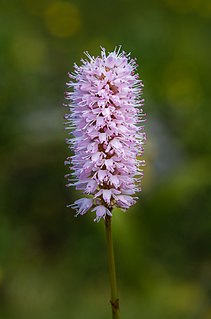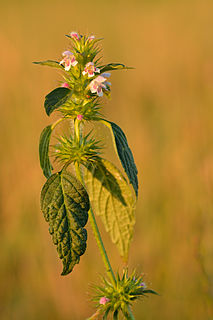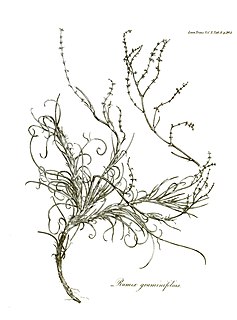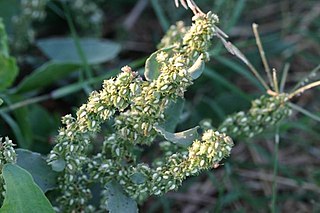
Bistorta officinalis, known as bistort, common bistort, European bistort or meadow bistort, is a species of flowering plant in the dock family Polygonaceae native to Europe and northern and western Asia. Other common names include snakeroot, snake-root, snakeweed and Easter-ledges.

The docks and sorrels, genus Rumex, are a genus of about 200 species of annual, biennial, and perennial herbs in the buckwheat family, Polygonaceae. Members of this genus are very common perennial herbs with a native almost worldwide distribution, and introduced species growing in the few places where the genus is not native.

Elodea canadensis is a perennial aquatic plant, or submergent macrophyte, native to most of North America. It has been introduced widely to regions outside its native range and was first recorded from the British Isles in about 1836.

Rumex obtusifolius, commonly known as bitter dock, broad-leaved dock, bluntleaf dock, dock leaf or butter dock, is a perennial plant in the family Polygonaceae. It is native to Europe, but is found on all temperate continents. It is a highly invasive species in some zones, resulting from its abundant seed dispersal, adaptability to reproduce, aggressive roots, ability to tolerate extreme climates, and hardiness.

Galeopsis tetrahit, the common hemp-nettle or brittlestem hempnettle, is a flowering plant in the family Lamiaceae, native to Europe and northwestern Asia.

Campanula trachelium, the nettle-leaved bellflower, is a species of bellflower. It is a Eurasian blue wildflower native to Denmark and England and now naturalized in southeast Ireland. It is also found southward through much of Europe into Africa.

Stachys sylvatica, commonly known as hedge woundwort, whitespot, or sometimes as hedge nettle, is a perennial herb growing to 80 cm tall in woodland and unmanaged grassland. In temperate zones of the northern hemisphere it flowers in July and August. The flowers are purple. The leaves, when crushed or bruised, give off an unpleasant fetid smell.
This page provides a glossary of plant morphology. Botanists and other biologists who study plant morphology use a number of different terms to classify and identify plant organs and parts that can be observed using no more than a handheld magnifying lens. This page provides help in understanding the numerous other pages describing plants by their various taxa. The accompanying page—Plant morphology—provides an overview of the science of the external form of plants. There is also an alphabetical list: Glossary of botanical terms. In contrast, this page deals with botanical terms in a systematic manner, with some illustrations, and organized by plant anatomy and function in plant physiology.

Ajuga pyramidalis, commonly known as pyramidal bugle, is a flowering plant of the genus Ajuga in the family Lamiaceae. It is a native plant in Europe.

Rumex hydrolapathum, the great water dock, water dock, or giant water dock, is a species of perennial herbaceous plants in the genus Rumex native to fens and freshwater banks of Europe and Western Asia. It is the tallest species in the genus, with flowering stems attaining a height of up to 2 m. It is one of the small number of decaploid organisms, containing two hundred individual chromosomes.
This glossary of botanical terms is a list of definitions of terms and concepts relevant to botany and plants in general. Terms of plant morphology are included here as well as at the more specific Glossary of plant morphology and Glossary of leaf morphology. For other related terms, see Glossary of phytopathology and List of Latin and Greek words commonly used in systematic names.

Rumex graminifolius, common name grassleaf sorrel, is a species of the genus Rumex and the knotweed family Polygonaceae.

Rumex stenophyllus is a species of flowering plant in the knotweed family known by the common name narrow-leaf dock. It is native to Eurasia and it can be found in parts of North America as an introduced species and roadside weed. It grows in moist and wet habitat, often in areas with saline soils. It is a perennial herb producing an erect stem from a thick taproot, usually measuring 40 to 80 centimeters tall, but known to well exceed one meter. The leaves are up to 30 centimeters long and are generally lance-shaped with curled edges. The inflorescence is an interrupted series of clusters of flowers with 20 to 25 in each cluster, each flower hanging from a pedicel. The flower has usually six tepals, the inner three of which are largest, triangular and edged with teeth, and bearing tubercles.
Rumex kerneri is a species of flowering plant in the knotweed family known by the common name Kerner's dock. It is native to Europe. It has also been observed in California as an introduced species and roadside weed. It is a perennial herb producing a slender, erect stem from a thick taproot, approaching 1.5 meters in maximum height. The lance-shaped leaves can be up to 25 centimeters long and have smooth, wavy, or wrinkly edges. The inflorescence is an interrupted series of clusters of flowers, with 15 or 20 in each cluster, each flower hanging from a pedicel. The flower has usually six tepals, the inner three of which are largest, about 6 millimeters long, edged with tiny teeth and bearing rounded tubercles in the centers.

Rumex pulcher is a species of flowering plant in the knotweed family known by the common name fiddle dock. It is native to Eurasia and North Africa and it can be found elsewhere, including parts of North America, as an introduced species and a roadside weed. Europe. It is quite variable in appearance, and some authorities divide it into several subspecies that are more or less distinguishable. In general, it is a perennial herb producing a slender, erect stem from a thick taproot, approaching 70 centimeters in maximum height. The top of the plant may bend, especially as the fruit develops. The leaves are up to 10 or 15 centimeters long and variable in shape, though often oblong with a narrow middle in the rough shape of a fiddle. The inflorescence is made up of many branches, each an interrupted series of clusters of flowers with up to 20 in each cluster, each flower hanging from a pedicel. The flower has usually six tepals, the inner three of which are edged with teeth and have tubercles at their centers.

Rumex alpinus, common name monk's-rhubarb, Munk's rhubarb or Alpine dock, is a leafy perennial herb in the family Polygonaceae. It is native to upland areas of Europe and Western Asia.

Rumex sanguineus, commonly known as bloody dock or red veined dock, is a perennial flowering plant species in the family Polygonaceae. Rumex sanguineus is a dicot and can be observed in Europe with at least two varieties

Rumex fueginus, known as American dock, golden dock, and Tierra del Fuego dock, is a flowering plant in the family Polygonaceae. Rumex fueginus was first formally named by Rodolfo Armando Phillipi. Rumex fueginus is native from Canada in northern North America to Tierra del Fuego at the southern tip of South America. It has previously been considered a subspecies or variety of Rumex maritimus, a Eurasian species.
Rumex utahensis is a flowering plant species in the family Polygonaceae. The common name for this species is Utah dock. It is a dicot, perennial herb that is native to the United states, growing only in the West.
Rumex fascicularis is a plant from the family Polygonaceae. This specific plant species experiences perennial growth and is originally found in North Carolina. Rumex fascicularis is from the genus Rumex, which are herbs and it is commonly seen growing near swamps, shores of rivers and lakes.
















